|
|
Thutmose III Obelisk (Also called: Theodosius Obelisk)
| Present Site: | Sultanahmet Square, Istanbul, Turkey N 41°00'21.3"(41.005922) E 28°58'31.4"(28.975384) |
| Pharaoh: | Thutmose III (The 18th Dynasty, reigned 15th Century BC) |
| Measurement: | 19.8 meters high for obelisk itself 25.6 meters including pedestal |
| Weight: | Unknown |
| Stone: | Red granite |
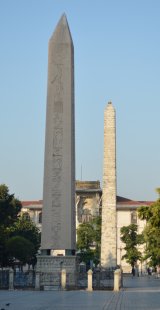
|
About The Site:
Sultanahmet Square is a square which spreads on north and west-side of Sultanahmet Mosque (the Blue Mosque). The obelisk site is a rectangular open space, where is the site of ancient Hippodrome, the Chariot race (two-wheeled vehicle racing by two horses) has been carried out in the Roman Empire. Hence the square is often called "Hippodrome" or it is sometimes also called "At Meydanı" ("Horse Square") in Turkish.
Sultanahmet District is a tourism center of Istanbul, many historical monuments and buildings such as Hippodrome (At Meydanı), Sultanahmet Mosque (the Blue Mosque), Basilica Cistern (underground cistern), Hagia Sophia, and Topkapı Palace (Topkapı Sarayı) are contained within the "Historic Areas of Istanbul", which became a UNESCO World Heritage Site.
The Hippodrome was originally built by Emperor Septimius Severus in AD 203, and Constantine the Great (Constantine I) renovated in 4th century. Probably he had a plan to erect the obelisk at the spina of this Hippodrome, but it has never happened during his lifetime.
Further, here is an another obelisk called "Constantine VII Column". According to Wikipedia, its original construction date is unknown, but it was repaired in 10th century by Emperor Constantine VII, hence the name is derived from his name. This piled the stone blocks, and is not an ancient obelisk, but is also called "Walled Obelisk". There is no inscription.
According to the picture in 2007, which is posted on the "Walled Obelisk" page of Wikipedia (above). the stone blocks look heavily damaged. But the stone blocks have been replaced with the new ones when I visited here in 2014, it looks fine. (See the picture at left).
How To Get There:
Getting off at Sultanahmet Station on T1 Line (tram), the vast park is in south side, and the Sultanahmet Mosque (the Blue Mosque) can be seen strait ahead. Not taking a way to the one like an open-air concert hall, shortly after taking a way to east direction, we'll arrive the Sultanahmet Square, spreading to southwest side.
Looking to the southwest direction from the entrance of Sultanahmet Square, two obelisks can be seen towards the back. The distance from the Sultanahmet Station to the obelisk is about 200 meters.
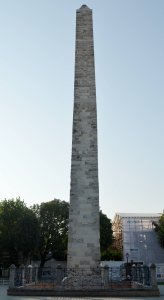 Constantinus VII Column (Walled Obelisk) in 2014
Constantinus VII Column (Walled Obelisk) in 2014
|
About The Obelisk:
This had once stood in Thebes: Although this obelisk is also called "Theodosius Obelisk" because Eastern Roman Emperor Theodosius I (Theodosius the Great) erected it, but originally Thutmose III (Ancient Egypt, The 18th Dynasty, reigned 15th Century BC) erected a pair of obelisks at South of 7th Pyron of Karnak Great Temple of Amun (Amon) in ancient Thebes (now, Luxor). This is the one of pairs. I confirmed that the left side of the obelisk with pedestal [of 7th Pyron] is missing at the site of Amun Temple in Luxor in 2016. Therefore, the one in the left side is considered as the current obelisk in Istanbul. Also confirmed that the southeast side of current obelisk was facing in front when it had been in Amun Temple.
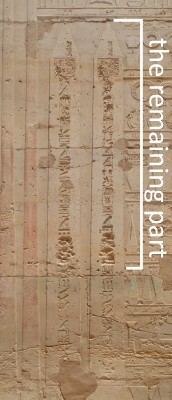 Remaining Part of the Obelisk
Remaining Part of the Obelisk
|
The relief which illustrates the obelisks were dedicated remains in the Festival Hall of Thutmose III, and one side of two obelisks are recorded. Looking the picture (at right) which I took in April 2016 at Amun Temple, and the inscription of Thutmose III Obelisk which remains in Istanbul, the inscription of obelisk at right side on the relief corresponds to the southeast side of Obelisk in Istanbul. Hence we can see that about one-third of the lower portion of the obelisk [of Istanbul] has been lost. (For high definition image, please click the picture)
Since the current length of the obelisk is 19.6 meters, it is estimated about 30 meters high with 400 tonnes when it was in the Great Temple of Amun in Karnak. This means this obelisk is next high obelisk to the World's highest Tuthmosis IV's Lateran Obelisk which is 32.18 meters high.
In the relief of Amun Temple, the name of Amun-Ra Deity is removed. In the fraction of another pair of obelisk which remains in Amun Temple, the name of Amun-Ra Deity is also said removed. The King who removed the name of Amun-Ra Deity is said Akhenaten (Echnaton, Amenhotep IV) in 14th century BC, who forced the religious reforms that the worship changed Amun-Ra Deity to Aten Deity.
Although the name of Amun-Ra Deity is removed, but the relief of northeast side of pyramidion of this Thutmose III Obelisk is not removed. The illustration that Thutmose III is dedicating a tribute to Amun-Ra Deity clearly remains with a little damage.
Considering this fact, I assume that the obelisk was already toppled in the religious reform era of Akhenaten, and (current) northeast side was facing down. Also I guess Ramses II (13th century BC) would add the inscriptions on this obelisk, like others, if this obelisk hasn't fallen.
The inscriptions of this obelisk beautifully remain on all four sides, and the typeface is also neat. The horus name and coronation name of Thutmose III are readable, but the birth name is not inscribed. It's unique that the writing styles of horus name and coronation name are different on each face.
Who carried the Obelisk: In the meantime, It's unknown who carried this Obelisk from Amun Temple in Thebes (Luxol) to Alexandria.
The obelisk which is called "Lateran Obelisk" currently in Rome was erected by Tuthmosis IV at east side of the Festival Hall of Thutmose III. The Roman Emperor Constantine I (reigned AD 306-337) instructed to erect this obelisk in his new capital town Constantinople (now Istanbul). However, it has not transported to Constantinople although it has successfully transported to Alexandria (from Thebes) during his reign. Later, that obelisk was transported to Rome, and currently in Piazza di San Giovanni in Laterano, Rome.
When the transportation of Tuthmosis IV Obelisk (current Lateran Obelisk) was ordered, the transportation of another obelisk, Thutmose III Obelisk (current Istanbul Obelisk) might be ordered. There are also other posibilities.
Because actually Tuthomosis IV obelisk was transported to Rome instead of Constantinople, it might be another obelisk was chosen for Constantinople in later period. But the details are unknown.
After this obelisk was kept in Alexandria for a while, this was transported to Constantinople by Emperor Theodosius I (reigned AD 379-395). Although it's said it has erected in Constantinople in AD 390, but it's also uncertain. Anyway, it has probably erected by AD 395 during his reign.
Keep Standing: It is noteworthy that this obelisk has kept standing at the same site since it was erected in Hippodrome of Constantinople in around 390. When the 4th Crusade attacked Constantinople in early 13th Century, the countless wealth were destroyed and plundered. At that time, the four bronze horses were also carried off from the Hippodrome, but the obelisk was left because it was too big. Just for your reference, this statue is now displayed on the west facade of the St. Mark's Basilica (Basilica San Marco) in Venice (Venezia). The current displayed statue is its replica, and the real one is stored indoor.
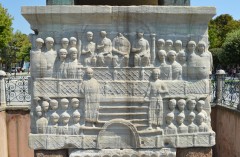 Relief on the pedestal, Southwest side
Relief on the pedestal, Southwest side
|
In addition, in spite of the military attack by the Turkish troops and the surrender of Byzantine Empire in 15th century, the obelisk miraculously remained without damage. At that time, Byzantine Empire became Ottoman Empire, and Constantinople
was renamed Istanbul. Ottoman Empire remained until Turkish Republic was established in 20th century.
About the Measurement: Although this obelisk is very well-known, but the height (length) of this obelisk isn't known and confusing. I assume that would be because discussing about the current whole height will have no academic significance, since the lower part of obelisk is lost. Wikipedia: "Obelisk of Theodosius" says, "18.54m (or 19.6m) high, or 25.6m if the base is included." It is strange that there are two different numbers are noted and the source of numbers is not clarified as well. On the other hand, according to "Cleopatra's Needles and Other Egyptian Obelisks" (by E. A. Wallis Budge), it's "about 50 feet high" (15.2 m) in the body text, but "55½ feet" (16.9 m) in the chapter of "LIST OF THE MOST IMPORTANT INSCRIBED OBELISKS NOW IN EXITENCE".
In this website, I'd say "19.8 meters (*1) high for obelisk itself, and 25.6 meters (*2) including pedestal", but they are not academicly certified numbers. If somebody knows the number which was written in the academic literature, please let me know.
(*1) The Obelisks of Egypt, Labib Habachi.
(*2) Wikipedia "Obelisk of Theodosius".
About the Pedestal: The obelisk stands on the marble pedestal with relief on 4 sides. (See Picture) The pedestal was made by the order of Emperor Theodosius I when the obelisk was erected here in late 4th Century. The reliefs on the pedestal depict Theodosius and his family and aides watching the races in the hippodrome and tell the story of how the obelisk was erected. Besides those reliefs, the inscriptions in Latin and Greek languages are engraved. The detailed explanations with many pictures can be seen in Obelisk of Theodosius page of Wikipedia.
Notes For Pictures:
Sultanahmet District is always busy with tourists because many interesting sightseeing spots are concentrated.
In January 2016, suicide bombings by members of the "ISIS" has occurred at south side of this Thutmose III Obelisk. I was very surprised with this happening because I have been here 2 years ago.
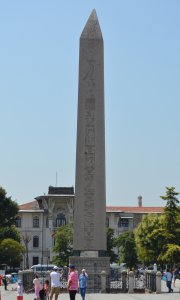 Northeast Side |
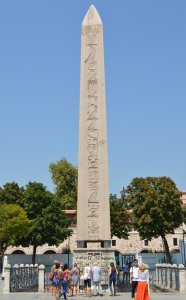 Southeast Side |
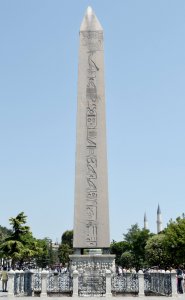 Southwest Side |
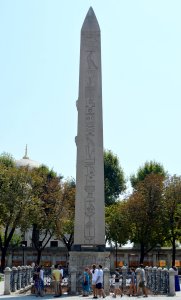 Northwest Side |
|||
August 11, 2014 by Hiroyuki Nagase (For high definition image, please click the picture) | ||||||
Copyright Hiroyuki Nagase nagase@obelisks.org and Shoji Okamoto okamoto@obelisks.org